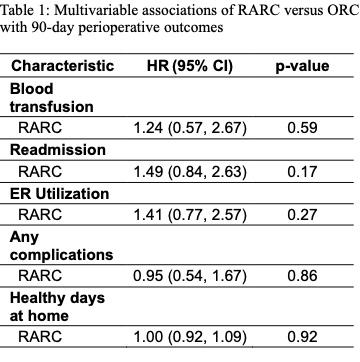BACKGROUND: Radical cystectomy (RC) is associated with substantial perioperative morbidity. While robotic-assisted surgical approaches have been associated with reduced morbidity in various settings, real-world data on the comparative effectiveness of robotic-assisted radical cystectomy (RARC) compared to open RC (ORC) are lacking. We therefore examined the association of RARC versus ORC with real-world 90-day postoperative outcomes among older adults with bladder cancer.
METHODS: We conducted observational analyses to emulate a hypothetical target trial of RARC versus ORC. We identified adults aged 66-89 years with stage Tis/T1-4, N0-1, M0 urothelial carcinoma of the bladder diagnosed from 2007-2017 in SEER-Medicare and treated with RARC or ORC. We excluded patients who previously underwent major abdominopelvic surgery. A propensity score for treatment was estimated using logistic regression, and the associations of RARC versus ORC with post-operative morbidity outcomes were evaluated using stabilized inverse probability of treatment weighting (sIPW) to adjust for differences in baseline characteristics.
RESULTS: The study cohort included a total of 1,914 patients, of whom 232 (12%) underwent RARC and 1682 (88%) of patients underwent ORC. Charlson comorbidity index was 3+ in 469 (25%) patients, while 727 (38%) patients were current/former smokers, and 246 (13%) patients received neoadjuvant chemotherapy. Baseline characteristics were well-balanced after sIPW adjustment. After adjustment, RARC was not associated with differences in perioperative blood transfusion (28% vs 24%; p=0.59), ER utilization (39% vs 31%; p=0.27), 90-day hospital readmission (47% vs 37%; p=0.17), 90-day complications (64% vs 65%; p=0.86), or 90-day healthy days at home (median 79 [IQR 65-84] versus 78 [IQR 65-83]; p=0.58), compared to ORC. RARC was associated with a lower adjusted rate of 90-day gastrointestinal complications (25% vs 35%; p=0.04), but no difference in any other complication category. Similar results were obtained in adjusted regression models (Table 1).
CONCLUSIONS: In observational analyses designed to emulate a hypothetical target trial, RARC was not associated with differences in perioperative blood transfusion or 90-day ER utilization, hospital readmission, total complications, or health days at home, compared to ORC.
